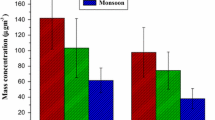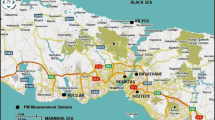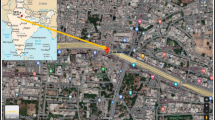Abstract
This study reports the quantification of the toxicity of particulate matter (PM)-bound metals and their possible associated risks to human health. For assessment of PM, 24-h samples of PM10 and PM2.5 were collected by Mini Vol-TAS sampler at an urban site of Pune. Samples were sequentially extracted with ultrapure water and concentrated HNO3 and analyzed for “soluble” and “total” metals. Factor analysis identified the resuspension of road dust due to traffic, biomass burning, construction activities, and wind-blown dust as possible sources that played an important role for overall pollution throughout the year. Water-soluble proportion was found to be ≤20 % for Cr, Co, Fe, and Al; ≥50 % for Sr, Cd, Ca, and Zn; and a substantial proportion (∼25–45 %) for Mn, Ba, K, Na, Ni, Mg, Cu, and Pb metals in PM10. For PM2.5, the water-soluble proportion was ≤20 % for Fe, Co, Ni, Cr, and Al, while Sr, K, and Cd were mostly soluble (>50 %) and Cu, Ba, Mn, Ca, Zn, Pb, Na, and Mg were substantially soluble (∼25–45 %). In the present study, among the toxic metals, Cd and Pb show higher concentration in the soluble fraction and thus represent the higher bioavailability index and especially are harmful to the environment and exposed person. Risk calculations with a simple exposure assessment method showed that the cancer risks of the bioavailable fractions of Cr, Cd and Ni were greater than the standard goal.






Similar content being viewed by others
References
Adomson, I. Y. R., Prieditis, H., Hedgecock, C., & Vincent, R. (2000). Zinc is the toxic factor in the lung response to an atmospheric particulate sample. Toxicology and Applied Pharmacology, 166, 111–119.
Arditsoglou, A., & Samara, C. (2005). Levels of total suspended particulate matter and major trace elements in Kosovo: a source identification and apportionment study. Chemosphere, 59, 669–678.
Balchandran, S., Meena, B. R., & Khillare, P. S. (2000). Particle size distribution and its elemental composition in the ambient air of Delhi. Environmental International, 26, 49–54.
Callen, M. S., de la Cruz, M. T., Lopez, J. M., Navarro, M. V., & Mastral, A. M. (2009). Comparison of receptor models for source apportionment of the PM10 in Zaragoza (Spain). Chemosphere, 76, 1120–1129.
Chillrud, S. N., Epstein, D., Ross, J. M., Sax, S. N., Pederson, D., Spengler, J., et al. (2004). Elevated airborne exposures of teenagers to manganese, chromium, and iron from steel dust and New York City’s subway system. Environmental Science and Technology, 38(3), 732–737.
Costa, D. L., & Dreher, K. L. (1997). Bioavailable transition metals in particulate matter mediate cardiopulmonary injury in healthy and compromised animal models. Environmental Health Perspectives, 105, 1053–1060.
Dockery, D. W., Pope, C. A., Xu, X., Spengler, J. D., Ware, J. H., Fay, M. E., et al. (1993). An association between Air Pollution and Mortality in six U.S. cities. The New England Journal of Medicine, 329, 1753–1759.
Dreher, K. L., Jaskot, R. H., Lehmann, J. R., Richards, J. H., McGee, J. K., Ghio, A. J., et al. (1997). Soluble transition metals mediate residual oil fly ash induced acute lung injury. Journal of Toxicology and Environmental Health, 50, 258–305.
Feng, X. D., Dang, Z., Huang, W. L., & Yang, C. (2009). Chemical speciation of fine particle bound trace metals. Int. J. Environ. Sci. Tech., 6(3), 337–346.
Frampton, M. W., Ghio, A. J., Samet, J. M., Carson, J. L., Carter, J. D., & Devlin, R. B. (1999). Effects of aqueous extracts of PM10 filters from the Utah Valley on human airway epithelial cells. American Journal of Physiology, 277, L960–L967.
Friberg, L., Nordberg, G. F., Vouk, V. B. (1986). Handbook on the toxicology of metals, 2nd. Ed., Elsevier Science and Technology, 5–6.
Guerzoni, S., Molinaroli, E., Rossini, P., Rampazzo, G., Quarantotto, G., de Falco, G., et al. (1999). Role of desert aerosol in metal fluxes in the Mediterranean area. Chemosphere, 39, 229–246.
Gupta, A., Kumar, R., Kumari, K. M., & Srivastava, S. S. (2003). Measurement of NO2, HNO3, NH3, and SO2 and related particulate matter at a rural site in Rampur, India. Atmospheric Environment, 37, 4837–4846.
Gupta, I., & Kumar, R. (2006). Trends of particulate matter in four cities in India. Atmospheric Environment, 40, 2552–2566.
Heal, M. R., Hibbs, L. R., Agius, R. M., & Beverland, I. J. (2005). Total and water-soluble trace metal content of urban background PM10, PM2.5 and black smoke in Edinburgh, UK. Atmospheric Environment, 39, 1417–1430.
Hlavay, J., Polyák, K., Molnár, A., & Mészáros, E. (1998). Determination of the distribution of elements as a function of particle size in aerosol samples by sequential leaching. Analyst, 123, 859–863.
Hsu, S. C., Lin, F. J., & Jeng, W. L. (2005). Seawater solubility of marine aerosols associated natural and anthropogenic metals. Atmospheric Environment, 39, 3989–4001.
Huang, L., Wang, K., Yuan, C. S., & Wang, G. (2010). Study on the seasonal variation and source apportionment of PM10 in Harbin. China. Aerosol Air Qual. Res., 10, 86–93.
IARC (International Agency for Research on Cancer). (2004a). Recent Meetings, vol. 87: Inorganic and organic lead compounds 10–17 February 2004. IARC Monographs on the Evaluation of Carcinogenic Risk to Humans. Available online at /http://monographs.iarc.fr/ENG/Meetings/vol87.phpS. Accessed 18 July 2012.
IARC (International Agency for Research on Cancer). (2004b). Some Drinking-Water Disinfectants and Contaminants, including Arsenic, vol. 84. Available online at /http://monographs.iarc.fr/ENG/Monographs/vol84/volume84.pdfS. Accessed 18 July 2012.
Janssen, N. A. H., Van Mansom, D. F. M., Van Der Jagt, K., Harssema, H., & Hoek, G. (1997). Mass concentration and elemental composition of airborne particulate matter at street and background locations. Atmospheric Environment, 31, 1185–1193.
Jimenez, L. A., Thompson, J., Brown, D. A., Rahman, I., Antonicelli, F., Duffin, R., et al. (2000). Activation of NFkappa B by PM10 occurs via an iron-mediated mechanism in the absence of I kappa B degradation. Toxicology and Applied Pharmacology, 166, 101–110.
Kappos, A. D., Bruckmann, P., Eikmann, T., Englert, N., Heinrich, U., Höppe, P., et al. (2004). Health effects of particles in ambient air. International Journal of Hygiene and Environmental Health, 207, 399–407.
Karar, K., & Gupta, A. K. (2006). Seasonal variations and chemical characterization of ambient PM10 at residential and industrial sites of an urban region of Kolkata (Culcutta), India. Atmospheric Research, 81, 36–53.
Karar, K., Gupta, A. K., Kumar, A., & Biswas, A. K. (2006). Characterization and identification of the sources of chromium, zinc, lead, cadmium, nickel, manganese, and iron in PM10 at two sites of Kolkata, India. Environ Monit Assem, 120, 347–360.
Kersten, M., Kriews, M., & Forstner, U. (1991). Partitioning of trace metals released from polluted marine aerosols in coastal seawater. Marine Chem., 36, 165–182.
Khillare, P. S., Balchandran, S., & Meena, B. R. (2004). Spatial and temporal variation of heavy metals in atmospheric aerosol of Delhi. Environmental Monitoring and Assessment, 90, 1–21.
Kothai, P., Saradhi, I. V., Pandit, G. G., Markwitz, A., & Puranik, V. D. (2011). Chemical characterization and source identification of particulate matter at an urban site of Navi Mumbai, India. Aerosol and Air Quality Research, 11, 560–569.
Krishna, R.R. (2012) Current atmospheric aerosol research in India. Current Science, vol. 102, no. 3.
Kulshrestha, A., Satsangi, P. G., Masih, J., & Taneja, A. (2009). Metal concentration of PM2.5 and PM10 particles and seasonal variations in urban and rural environment of Agra, India. Science of the Total Environment, 407, 6196–6204.
Kulshrestha, U. C., Jain, M., Sekar, R., Vairamani, M., Parashar, D. C., & Sarkar, A. K. (2001). Chemical characteristics and source apportionment of aerosols over Indian Ocean during INDOEX-1999. Current Science, 80, 180–185.
Kulshrestha, U. C., Saxena, A., Kumar, N., Kumari, K. M., & Srivastava, S. S. (1998). Chemical composition and association of size-differentiated aerosols at a suburban site in a semi –arid tract of India. J Atmos Chem, 29, 109–118.
Kumar, A., Sudheer, A. K., & Sarin, M. M. (2008). Chemical characteristics of aerosols in MABL of Bay of Bengal and Arabian Sea during spring inter-monsoon: a comparative study. J Earth Syst Sci, 117, 325–332.
Kumar, R., Rani, A., Kumari, K. M., & Srivastava, S. S. (2003). Direct measurement of atmospheric dry deposition to natural surfaces in a semiarid region of north central India. Journal of Geophysical Research, 108(D20), 4625.
Kumar, R., Srivastava, S. S., & Kumari, K. M. (2007). Characteristics of aerosols over suburban and urban site of semiarid region in India: seasonal and spatial variations. Aerosol Air Quality Res., 7, 531–549.
Kumar, R. K., Kumari, M., & Srivastava, S. S. (2006). Field measurements of aerosol particle dry deposition on tropical foliage at an urban site. Environmental Science and Technology, 40, 135–141.
Lee, R. E., & von Lehmden, D. J. (1973). Trace metal pollution in the environment. Journal of the Air Pollution Control Association, 23(10), 853–857.
Mouli, P. C., Mohan, S. V., & Reddy, S. J. (2006). Chemical composition of atmospheric aerosol (PM10) at semi arid urban site: influence of terrestrial sources. Environmental Monitoring and Assessment, 117, 291–305.
Nair, P. R., George, S. K., Sunilkumar, S. V., Parameswaran, K., Jocab, S., & Abraham, A. (2006). Chemical composition of aerosols over peninsular India during winter. Atmospheric Environment, 40, 6477–6493.
Negi, B. S., Sadasivan, S., Nambi, K. S. V., & Pande, B. M. (1996). Characterization of atmospheric dust at Gurushikar, Mt. Abu, Rajasthan. Environmental Monitoring and Assessment, 40(3), 253–259.
Ondov, J. M., Choquette, C. E., Zoller, W. H., Gordon, G. E., Biermann, A. H., & Hef, R. E. (1989). Atmospheric behavior of trace elements on particles emitted from a coal-fired power plant. Atmospheric Environment, 23(10), 2193–2204.
Parashar, D. C., Kulshrestha, U. C., & Jain, M. (2001). Precipitation and aerosol studies in India. Environmental Monitoring and Assessment, 66, 47–61.
Park, S. S., & Kim, Y. J. (2005). Source contributions to fine particulate matter in an urban atmosphere. Chemosphere, 59, 217–226.
Parmar, R. S., Satsangi, G. S., Kumari, M., Lakhani, A., Srivastav, S. S., & Prakash, S. (2001). Study of size distribution of atmospheric aerosol at Agra. Atmospheric Environment, 35, 693–702.
Perry, K. D. (1999). Effects of outdoor pyrotechnic displays on the regional air quality of western Washington State. Journal of the Air & Waste Management Association, 49, 146–155.
Que Hee, S. S., Finelli, V. N., Fricke, F. L., & Wolnik, K. A. (1982). Metal content of stack emissions, coal and fly ash from some eastern and western power plants in the U.S.A. as obtained by ICP-AES. International Journal of Environmental Analytical Chemistry, 13, 1–18.
Quiterio, S. L., da Silva, C. R. S., Arbilla, G., & Escaleira, V. (2004). Metals in airborne particulate matter in the industrial district of Santa Cruz, Rio de Janeiro, in an annual period. Atmospheric Environment, 38, 321–331.
Qureshi, S., Dutkiewicz, V. A., Khan, A. R., Swami, K., Yang, K. X., Husain, L., et al. (2006). Elemental composition of PM2.5 aerosols in Queens, New York: solubility and temporal trends. Atmospheric Environment, 40, S238–S251.
Raven, K. P., & Loeppert, R. H. (1997). Heavy metals in the environment: trace element composition of fertilizers and soil amend-ments. Journal of Environmental Quality, 26, 551–557.
Reddy, L. A. K., Kulshrestha, U. C., Satyanarayana, J., Kulshrestha, M. J., & Moorthy, K. K. (2008). Chemical characteristics of PM10 aerosols and air mass trajectories over Bay of Bengal and Arabian Sea during ICARB. J Earth Syst Sci, 117, 345–352.
Safai, P. D., Rao, P. S. P., Momin, G. F., Ali, K., Chate, D. M., Praveen, P. S., et al. (2005). Variation in the chemistry of aerosols in two different winter seasons at Pune, Sinhagad. India. Aer Air Qual Res, 5, 115–126.
Schleicher, N. J., Norra, S., Chai, F., Chen, Y., Wang, S., Cen, K., Yu, Y., Stuben, D. (2011). Temporal variability of trace metal mobility of urban particulate matter from Beijing- A contribution to health impact assessments of aerosols. Atmospheric Environment, 45, 7248–7265
Schwartz, J., Dockery, D. W., & Neas, L. M. (1996). Is daily mortality associated specifically with fine particles? Journal of the Air & Waste Management Association, 46, 927–939.
Shah, M. H., & Shaheen, N. (2010). Seasonal behaviours in elemental composition of atmospheric aerosols collected in Islamabad, Pakistan. Atmospheric Research, 95, 210–223.
Shah, M. H., Shaheen, N., Jaffar, M., Khalique, A., Tariq, S. R., & Manzoor, S. (2006). Spatial variations in selected metal contents and particle size distribution in an urban and rural atmosphere of Islamabad, Pakistan. Journal of Environmental Management, 78, 128–137.
Sharma, M., Kishore, S., Tripathi, S. N., & Behera, S. N. (2007). Role of atmospheric ammonia in the secondary particulate matter: a study at Kanpur, India. J Atmos Chem, 58, 1–17.
Sharma, M., & Maloo, S. (2005). Assessment of ambient air PM10 and PM2.5 and characterization of PM10 in the city of Kanpur, India. Atmospheric Environment, 39, 6015–6026.
Shi, X., Mao, Y., Knapton, A. D., Ding, M., Rojanasakul, Y., Gannett, P. M., et al. (1994). Reaction of Cr(VI) with ascorbate and hydrogen peroxide generates hydroxyl radical and causes DNA damage: role of a Cr(IV)-mediated Fenton-like reaction. Carcinogenesis, 15(11), 2475–2478.
Smichowski, P., Polla, G., & Gómez, D. (2005). Metal fractionation of atmospheric aerosols via sequential chemical extraction: a review. Analytical and Bioanalytical Chemistry, 381, 302–316.
Tiwari, S., Kulshrestha, U. C., & Padamanabhamurty, B. (2007). Monsoon rain chemistry and source apportionment using receptor modeling in and around National Capital Region (NCR) of Delhi, India. Atmospheric Environment, 41, 5595–5604.
Tsai, Y. I., & Cheng, M. T. (2004). Characterization of chemical species in atmospheric aerosols in a metropolitan basin. Chemosphere, 54, 1171–1181.
VAPCD (1998). The air toxics report Appendix A, Category I-Algorithm and Tables. The Vermont Air Pollution Control Division. http://www.anr.state.vt.us/air/AirToxics/docs/ AirToxReportAppendix_A.pdf. Accessed 18 July 2012.
Vousta, D., & Samara, C. (2002). Labile and bioaccessible fractions of heavy metals in the airborne particulate matter from urban and industrial areas. Atmospheric Environment, 36, 3583–3590.
Watson, J. G., Zhu, T., Chow, J. C., Engelbrecht, J., Fujita, E. M., & Wilson, W. E. (2002). Receptor modeling application framework for particle source apportionment. Chemosphere, 49, 1093–1136.
Acknowledgments
The authors wish to thank Department of Science and Technology (DST no. SR/FTP/ES-91/2009), New Delhi and BCUD, Pune for the financial assistance. The authors also express their gratitude to the Head the Department of Chemistry, University of Pune, for his encouragement. IIT, SAIF–Mumbai is also acknowledged for analyzing the samples on ICP.
Author information
Authors and Affiliations
Corresponding author
Rights and permissions
About this article
Cite this article
Yadav, S., Satsangi, P.G. Characterization of particulate matter and its related metal toxicity in an urban location in South West India. Environ Monit Assess 185, 7365–7379 (2013). https://doi.org/10.1007/s10661-013-3106-6
Received:
Accepted:
Published:
Issue Date:
DOI: https://doi.org/10.1007/s10661-013-3106-6




